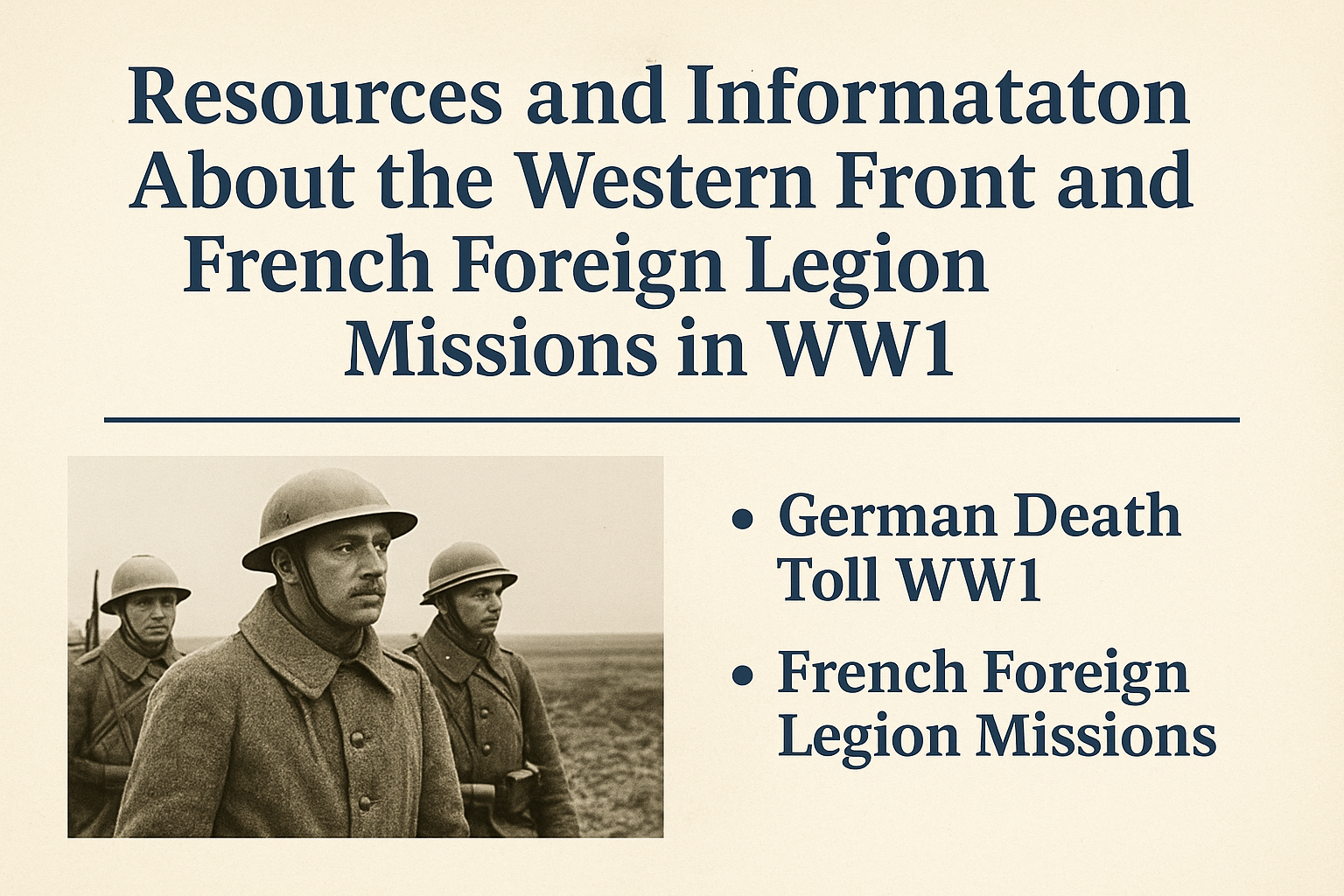
Resources and Information About the Western Front and French Foreign Legion Missions in WW1
Published on May 05, 2025
Resources and Information on WW1: Exploring the Western Front and French Foreign Legion Missions
World War I, often dubbed “The Great War,” reshaped the political, social, and military landscapes of Europe. Among the most intense and historically significant regions of conflict was the Western Front, a place of unrelenting trench warfare and enormous human loss. Meanwhile, the French Foreign Legion, known for its elite and diverse composition, carried out missions that added a unique dimension to the war’s military strategies.
Whether you're a history enthusiast, uniform collector, or a researcher looking for in-depth information, understanding the key figures, battles, and roles played on the Western Front is essential. This article explores valuable WW1 resources and insights, including who fought at the Western Front and how the French Foreign Legion missions shaped the course of the war.
The Western Front: Where It Was and Why It Mattered
The Western Front was a 400-mile stretch of fortified trenches, running from the North Sea coast of Belgium through northern France to the Swiss border. It was the primary battleground between the Allied Powers (mainly France, the British Empire, Belgium, and later the United States) and the Central Powers, predominantly Germany.
Where Was the Western Front?
- Belgium (Flanders region) – Known for the bloody battles of Ypres and Passchendaele.
- Northern France – This includes major conflict zones such as the Somme and Verdun.
- Alsace-Lorraine – A disputed region heavily fortified by both German and French troops.
This front was characterized by trench warfare, with opposing armies dug in just yards apart, leading to prolonged stalemates and devastating losses.
Who Fought at the Western Front?
Understanding who fought at the Western Front paints a vivid picture of the war's global scale:
- French Army: Defending their homeland with heavy casualties in battles like Verdun.
- British Expeditionary Force (BEF): Played a key role at the Somme and Ypres.
- Belgian Army: Crucial in early resistance against the German invasion.
- German Empire: The primary aggressor on the Western Front.
- United States Army: Joined the Allies in 1917, bringing fresh troops and resources.
Troops from the British Empire also included Canadians, Australians, New Zealanders, and Indians, while African and colonial French soldiers also fought in large numbers.
French Foreign Legion Missions During WW1
The French Foreign Legion was already renowned for its valor and discipline before WW1, but its contribution to the war cemented its place in military history.
What Were the French Foreign Legion Missions?
The French Foreign Legion was involved in some of the most brutal battles of the war:
- Battle of the Marne (1914): Held back German advances in the early days of the war.
- Champagne Offensive (1915): High casualties but strategic gains.
- Battle of Verdun (1916): Legionnaires fought heroically alongside regular French troops.
The Legion’s units often served as shock troops, deployed in high-risk offensives where other units struggled to make progress.
Why Was the French Foreign Legion Important?
- Diverse Composition: Made up of volunteers from around the world, including Americans, Russians, and even former enemies.
- Elite Training: Well-disciplined and physically tough, making them ideal for front-line duties.
- Symbol of French Resilience: Their service and sacrifice were celebrated in wartime propaganda and remembrance.
For collectors and history buffs, Legionnaire uniforms and medals from this period are prized items, offering a tangible link to this storied force.
The German Death Toll in WW1
One of the most sobering aspects of the war was its staggering human cost. The German death toll during WWI is estimated at over 2 million soldiers, with millions more wounded.
Key Reasons for the High Death Toll:
- Static Trench Warfare: Left soldiers exposed to artillery, gas attacks, and machine-gun fire.
- Poor Medical Support: Especially early in the war.
- Mass Conscription: Many untrained and ill-equipped young men were sent to the front lines.
In comparison, France suffered approximately 1.4 million military deaths, and Britain over 880,000.
This death toll underscores the harsh realities of war and emphasizes the importance of preserving military history through artifacts and education.
Useful Resources for Learning More
For those wanting to explore more deeply, here are some trusted sources and tools for WW1 research and military collectibles:
- Imperial War Museums (IWM)
- The National WW1 Museum (Kansas City)
- Service records and war diaries are available online
- Military uniform databases and auction sites
- Paddelaters.com’s collection of authentic WW1 uniforms and memorabilia
Our website curates a historically accurate collection of uniforms, gear, and accessories from WWI, with a focus on authenticity and educational value.
Why Historical Military Uniforms Matter
Preserving and studying war uniforms from the Western Front and the French Foreign Legion does more than appeal to collectors—it tells a story. Uniforms reflect:
- Rank and role
- Nationality
- Changes in military strategy
- Conditions of service
At Paddelaters.com, we are committed to providing authentic and well-documented war uniforms that help bring history to life.
Final Thoughts: Why You Should Care About These Stories
History is more than dates and numbers—it's about people, sacrifice, and resilience. Understanding who fought at the Western Front and what the French WW1 Foreign Legion endured gives us a window into one of the most defining moments of the 20th century.
